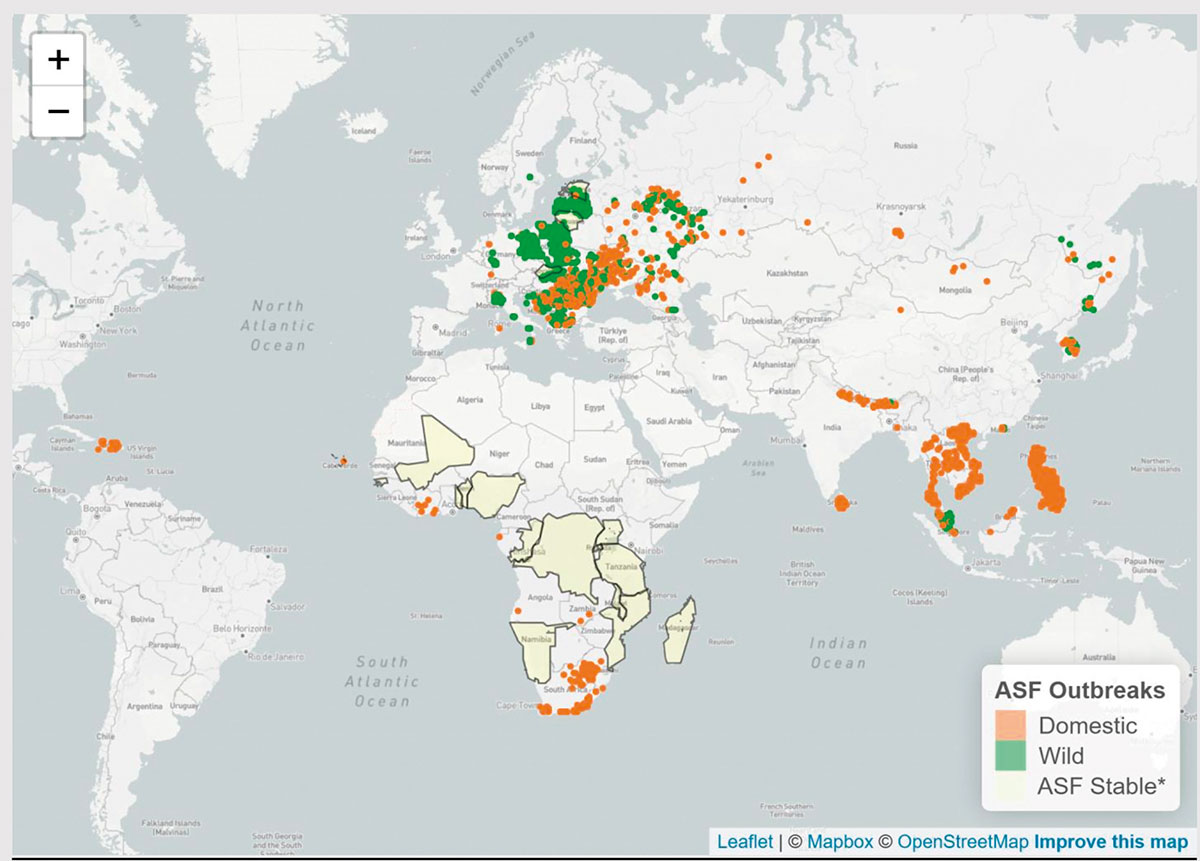 African swine fever (ASF) is a truly global pig disease that has repeatedly proven in recent years to be very easy to spread, but, once it takes hold, incredibly difficult to get rid of.
African swine fever (ASF) is a truly global pig disease that has repeatedly proven in recent years to be very easy to spread, but, once it takes hold, incredibly difficult to get rid of.
Responsible for massive losses in pig populations and drastic economic consequences, ASF has ‘become a major crisis for the pork industry in recent years’, according to the World Organisation for Animal Health (WOAH).
WOAH’s latest ASF update shows that in July 2025 alone, 11 countries in Europe, three in Asia and one in Africa reported outbreaks. A total of 83 new outbreaks were recorded in domestic pigs, with 19,241 ‘animal losses’, which also include animals culled on infected premises, and 193 outbreaks in wild boar.
And since January 2022, 67 countries and territories have reported the presence of the virus, 12 of these for the first time, while 11 have reported its spread to new zones.
In that time, there have been 1,024,062 cases in domestic pigs, with 2,170,124 ‘animal losses’ and 37,880 cases in wild boar. And these are just the recorded cases.
While a headline figure of 2 million domestic pig losses is stark in its own right, it only tells part of the story, given the huge wider impact on pig businesses as a result of restrictions and trade bans, and the enormous costs to industry and government.
Global African swine fever outbreaks

ASF’s global spread
ASF is a highly contagious viral disease of domestic and wild pigs, with a mortality rate that can reach 100%.
The virus is highly resistant in the environment, meaning it can survive on clothes, boots, wheels and other materials, as well as in pork products. This means that, while much of the global spread happens locally, via either wild boar, particularly in Europe, or domestic pigs, human spread within and across borders is often to blame.
Recent history has shown it can appear in a new country or region at any time, without warning. And it only takes one slip to create potentially untold damage. This is why there is so much focus on both our national biosecurity and our on-farm defences.
Africa
The first case of ASF is believed to have occurred in Kenya in 1907, although it wasn’t reported until 1921. It quickly spread to other countries in eastern and southern Africa and later to central and western countries. The virus was confined to Africa until 1957, when it was discovered in Portugal.
Back to the present day, South Africa faces the biggest ongoing ASF problem on the continent and was the only country to record a case in July, according to the WOAH report. In August, South Africa’s Farmer’s Weekly reported that a suspected outbreak in the Western Cape had resulted in the death of 331 pigs.
Over the past three years, isolated cases have been reported in other African countries, including Sierra Leone, Zambia and Angola. In total, since January 2022 there have been 844 recorded outbreaks in Africa, affecting 115,000 pigs, and six cases in wild boar.
Europe
After being detected in Portugal in 1957, ASF spread to Spain and France and was not eradicated from mainland Europe until the 1990s, only to reappear in 2007 in Georgia.
The Georgia outbreak near the Black Sea port of Poti was linked to a ship’s catering waste, including pork, that was dumped nearby. Genotyping traced the virus to outbreaks in Mozambique, Madagascar and Zambia.
Thought to be the start of the subsequent global spread, the virus quickly circulated within Georgia and to neighbouring countries Armenia and Azerbaijan by the end of the year, and then into Iran, Russia and Belarus, with wild boar a major factor in its spread.
Since then, it has spread relentlessly, initially across eastern Europe and then into central and western regions, sometimes gradually involving domestic pigs and wild boar and occasionally in huge leaps.
Notable milestones included the virus’s discovery in Poland in 2014, the Czech Republic in 2017, Romania in 2018 and, in a huge shock to western Europe’s pig sector, in wild boar in Belgium in 2018, hundreds of miles from the nearest outbreak.
In a far more seismic blow to the EU pig sector, ASF was discovered in Germany in wild boar close to the Polish border in September 2020. Nearly five years on, cases continue to be confirmed in domestic pigs and wild boar in the country.
Another shock was the discovery of ASF in northern Italy in 2022, with subsequent spread into various other parts of the country. A further unexpected long-distance jump resulted in a single case in Sweden in 2023.
In July alone, WOAH reported ongoing cases in Bosnia and Herzegovina, Croatia, Estonia, Germany, Hungary, Italy, Moldova, Poland, Romania and Ukraine, with 177 outbreaks in domestic pigs and 193 in wild boar between them.
There were media reports in August of Estonia being ‘on the edge’ as a result of a growing ASF epidemic, after a farm with 6,700 pigs was hit, and of the virus being detected on a farm in Latvia with nearly 5,000 pigs.
Since January 2022, WOAH reports a total of 4,733 outbreaks in domestic pigs in Europe, with 1.5 million pig losses, alongside 26,635 outbreaks in wild boar.
And, if further evidence of the virus’s foothold in Europe was needed, APHA’s latest ASF Europe update in June included reports on 20 countries with current or recent cases.
ASF in Europe in 2024
The European Food Safety Agency’s 2024 annual epidemiological report shows:
- 13 member states experienced cases in domestic pigs or wild boar, or both – Bulgaria, Croatia, Czech Republic, Estonia, Germany, Greece, Hungary, Italy, Latvia, Lithuania, Poland, Romania and Slovakia.
- 10 of these countries recorded outbreaks in domestic pigs. All reported cases in wild boar.
- Romania accounted for 66% of the total outbreaks.
- Seven non-EU member states recorded outbreaks – Albania, Bosnia and Herzegovina, Moldova, Montenegro, North Macedonia, Serbia and Ukraine.
Asia
Until 2018, Asia had largely steered clear of ASF. Then, in September of that year, China, which accounted for roughly half the world’s pigs produced and half of all pork consumed, reported its first case, sparking one of the biggest animal disease outbreaks in history.
According to the American Society for Microbiology, an estimated 225 million pigs in China either died or were culled due to the outbreak – almost 25% of the global pig population.
The virus subsequently spread to various other Asian nations, including Mongolia, Vietnam, Cambodia, Hong Kong, North Korea, Laos, Myanmar, the Philippines, South Korea, Indonesia, Timor-Leste and Papua New Guinea – some of which are huge pig-producing nations.
On top of the huge consequences for pigs, farmers, consumers and the authorities in the affected countries, the outbreaks resulted in huge shifts in the global trade of pork and other proteins, as Asian import demand, led by China, soared in the following years.
As the outbreaks in China and elsewhere were eventually brought under control, production has recovered, but the virus remains an issue in the continent.
More recently, Bhutan, India, Malaysia, and Thailand have reported outbreaks in domestic pigs and/or wild boar, while Sri Lanka reported its first case in October 2024.
Since January 2022, WOAH has recorded 6,422 outbreaks in domestic pigs in Asia, with 1.5 million domestic pig losses, but just 541 outbreaks in wild boar, highlighting how local spread between domestic pigs, often smallholdings, has been a key driver.
WOAH’s latest update highlighted just five cases in domestic pigs in Asia in July – in Cambodia, Korea and Malaysia.
However, Reuters reported in August that Vietnam is experiencing a surge in cases, while the Philippines has recorded more than 514 ASF outbreaks in 28 out of 34 provinces and cities since the start of the year, according to its agriculture ministry.
The Americas
The Americas have largely steered clear of ASF, beyond an outbreak in Cuba in 1971. In July 2021, however, an outbreak was confirmed in the Dominican Republic, in the Caribbean, close to the US’s south-east coast.
It has since eradicated the virus, but the development helped focus the US on its biosecurity defences against pig diseases.




